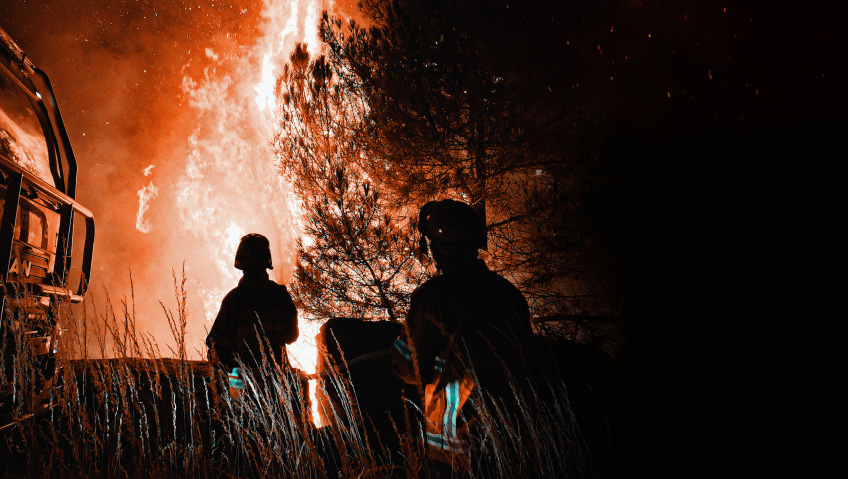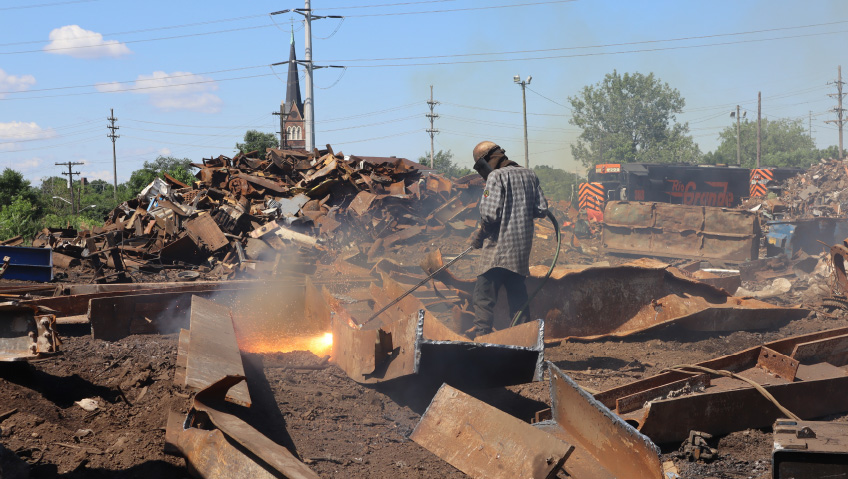Texas is no stranger to significant weather and environmental disasters. From Hurricane Carla in 1961 to Hurricane Harvey in 2017, Winter Storm Uri in 2021, and extreme heat and wildfires, flooding, and drought, no season is safe from weather extremes.
Most recently, a powerful storm system called a derecho slammed Houston. Hurricane-strength winds knocked out power to a million homes and businesses in the area and left several people dead in the wake of its destruction. The city scrambled to address emergency calls, gas leaks, and other dangerous infrastructural challenges. Just weeks before, torrential rain inundated the area, causing flooding substantial enough to warrant closures. The area received more than nine inches of rain in a 24-hour period and flash flooding warnings remained in effect for days.
Severe weather events like this are becoming all too common, the intensity of which have significantly strengthened over time. The presence and form of these crises are almost ironic as well. Too much rain causes massive flooding, but extreme temperatures and below average rainfall means aquifers are running dry, worsened by the presence of drought conditions, which is especially taxing for the economy both in terms of the loss of assets and loss of lives.
Between 1980 and 2022, 44 percent of all climate and weather disasters exceeding a billion dollars in damage impacted Texas, so the old saying might be true: everything really is bigger in Texas, even the impacts of natural disasters. In fact, the state is considered the U.S. state most vulnerable to climate change given the frequency and severity of these occurrences. According to Climate Check, the greatest risks facing the state are heat, precipitation, fire, and drought, with different areas of the state facing unique sets of challenges.
When compared to other states, Texas ranks 10th in terms of its risk for drought, 15th for fire, 36th when it comes to storm risk, and 38th for flood risk. What is more, it seems like there is no season from which the state is safe.
Heat records are being set in the month of May, before the summer has officially even arrived. Dallas and other parts of the state experience record-high temperatures, some extremes that haven’t been felt in close to a hundred years. At 116 degrees Fahrenheit, La Puerta was the hottest city in the country.
Last June was the second hottest summer on record, with the state experiencing 119 degrees Fahrenheit or 48 degrees Celsius. The frequency of extremely hot days is also increasing, which means there is little reprieve from the heat. By 2050, on average someone in Texas will experience an estimated 43 extremely hot days each year.
With this extreme heat, emergency rooms are experiencing greater demand, and greater numbers of people are dying, particularly vulnerable citizens like children and the elderly. Not everyone is equipped with air conditioners, fans, or the means to keep themselves cool, and when the power grid fails, these things are of no service or function.
Further to the individual impacts of the heat, elevated temperatures are also contributing to smog, ozone, and pollution, in addition to exacerbating wildfire conditions, which is another major issue facing the state.
West, south and central Texas face the greatest risk of wildfires. Drought conditions contribute to dryness that facilitates the rapid ignition and spread of fire. Where there is a risk of wildfire, it should be welcome news that the state is also experiencing more intense rainstorms causing flooding, but the reality is that on average, there is less rainfall. Average rainfall is down overall in the winter, spring, and summer months in Texas, which has decreased the rate of flow in rivers and streams, depleting the aquifer upon which many people, farmers, and businesses rely.
Since the 1950s, this aquifer has declined by 50 percent in some parts of the state. This water is of utmost importance to the agricultural foundation of the economy as well as electrical production upon which the economy depends. Further, historic flood plain maps no longer hold valid. Areas that never used to flood are flooding and those that were supposed to flood occasionally over the 100- and 500-year plains are flooding more frequently.
Particularly in the eastern two-thirds of the state, the annual rainfall continues to bring more intense rainstorms and flooding, but the soil continues to become drier, which is increasing the amount of desert in the state. This is due in large part to hotter temperatures causing evaporation, as well as increased usage, particularly during times of drought.
Coastal communities are particularly vulnerable to flooding and wind damage, as well as rising sea levels. Rising sea levels not only submerge land, but they also erode beaches, conditions amplified by the more intense hurricanes, tropical storms, winter storms, rainstorms, and tornados that continue to batter the state.
Along much of the coast, the sea is rising almost two inches a decade and the land is sinking, largely due to ground water pumping. These two things are a wicked combination that can have serious implications.
According to an interactive map created by Climate Central, an organization of scientists and journalists dedicated to the issue (Interactive map shows which Texas cities will be underwater in 2050 | KXAN Austin), many Texas cities will be underwater by 2050, the highest risk belonging to the southern coastline. If this comes to fruition, it will have a devastating human, environmental, and financial toll on the state.
Maintaining these communities, particularly ensuring the infrastructure is sufficient, will be costly, both from a financial perspective and a cost of life perspective. Not only are the lives of those who live and work along the coast at risk, these areas are major economic hubs that are becoming increasingly costly to insure and safeguard. These areas are home to major cities, critical infrastructure like railways, ports, and highways, and oil and gas infrastructure, which is a significant part of the state’s economic strength and identity.
Come wintertime, Texas faces a new kind of extreme. At the same time as cities in Texas are experiencing all-time temperature highs, the state is also seeing record lows, with several cities recording temperatures colder than experienced in Alaska.
Cold temperatures and winter storms like the Groundhog Day blizzard in 2011 that produced rolling blackouts across more than three-quarters of the state due to insufficient energy infrastructure and increased demand on the grid are also becoming more common. The storm caused the loss of power, roads were impassable, and there were water, food, and heat shortages that led to major losses. More than 4.5 million homes and businesses were without power, and hundreds of people lost their lives either directly or indirectly due to the storm. It cost upwards of $200 billion to recover from this storm.
The storm shone a light on the fact that Texas’ electrical grid needed significant upgrades, but the cost of winterizing the system was so great that the recommendations of North American energy regulators have been ignored by state leadership, and the costs of cleanup were likely greater than the costs to upgrade would have been. The Dallas Morning News reported that Dallas-Fort Worth hit a record low of minus two degrees, marking the coldest day on record in North Texas in 72 years.
With every massive storm, and through the gradual changes caused by shifting climate patterns, the state’s existing infrastructure and established way of life becomes more strained, which requires immediate action on the part of the state’s leadership.
The Intergovernmental Panel on Climate Change says that emissions need to be reduced to keep the globe from warming beyond 1.5 degrees Celsius. To have a 66 percent chance of preventing the temperature from exceeding 1.5 degrees, greenhouse gas emissions need to be cut 45 percent by 2030, and net zero needs to be achieved by 2050. To be closer to 100 percent, net zero would need to be achieved by 2040—an extremely lofty goal.
Much of the state of Texas has already warmed one-half to a full degree in the past century. Of the challenges that rising temperatures present, for every one degree Celsius the atmosphere warms, it holds approximately seven percent more moisture.
To overcome this, it will require massive action on the part of the state and federal governments, as well as local support from the municipalities, which is likely to take time—but there are things that can be done sooner to insulate the state from the ravaging impacts of these natural disasters. Be it investments in the state’s infrastructure—including its power grid to ensure it stands up to increased demand and volatility—or safeguarding individuals with the means necessary to keep themselves warm, cool, and protected from the inevitable shifts in weather being faced, it is time to take these matters seriously to mitigate the costly impacts to life and property.






